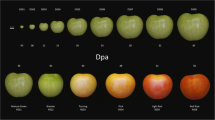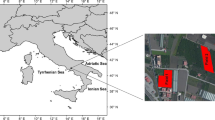Abstract
A non-destructive assessment using visible/near-infrared spectroscopy and machine vision has been investigated for measuring tomato ripeness. Relationship between spectral wavelengths and green grayscale value was evaluated by application of chemometrics techniques based on partial least squares (PLS) regression. The tomatoes were divided randomly into two groups: 170 fruits for calibration and 71 for prediction. An accurate estimation, measured with a correlation coefficient of 0.992 and root mean square errors of prediction (RMSEP) of 9.92, was obtained when using the developed PLS model built with 550–750 nm spectral range. The accuracies of calibration and validation models based on data measured in this band were 90.93 and 90.05%. The prediction accuracy for 150 external independent samples was 90.67%. The results show that it is possible to realize detection standardization of tomato maturity based on only visible spectroscopy (550–750 nm) and machine vision technologies. This detection method does not depend on a visual grading or other maturity indices as a reference. It highlights the potential of the method to determine tomato ripeness and the optimum harvest time.



Similar content being viewed by others
References
Acevedo FJ, Jiménez J, Maldonado S, Domínguez E, Narváez A (2007) Classification of wines produced in specific regions by UV-visible spectroscopy combined with support vector machines. J Agric Food Chem 55:6842–6849
Büning-Pfaue H (2003) Analysis of water in food by near infrared spectroscopy. Food Chem 82:107–115
Camps C, Toussirot M, Quennoz M, Simonnet X (2011) Determination of artemisinin and moisture content of Artemisia annua L. dry powder using a hand-held near infrared spectroscopy device. J Near Infrared Spectrosc 19:191–198
El-Bendary N, El Hariri E, Hassanien AE, Badr A (2015) Using machine learning techniques for evaluating tomato ripeness. Expert Syst Appl 42(4):1892–1905
Elhariri, E., El-Bendary, N., Fouad, M. M. M., Platoš, J., Hassanien, A. E., & Hussein, A. M. (2014). Multi-class SVM based classification approach for tomato ripeness. In: Innovations in Bio-inspired Computing and Applications (pp. 175–186). Springer International Publishing.
Feng F, Wu Q, Zeng L (2015) Rapid analysis of diesel fuel properties by near infrared reflectance spectra. Spectrochim Acta A Mol Biomol Spectrosc 149:271–278
Goel N, Sehgal P (2015) Fuzzy classification of pre-harvest tomatoes for ripeness estimation—an approach based on automatic rule learning using decision tree. Appl Soft Comput 36:45–56
Gómez AH, Hu G, Wang J, Pereira AG (2006) Evaluation of tomato maturity by electronic nose. Comput Electron Agric 54(1):44–52
Greenshields MWCC, Cunha BB, Mamo MA, Coville NJ, Hümmelgen IA (2015) Non-destructive tomato ripeness determination using carbon nanostructure based chemical sensors. Application of tristimulus and principal component analysis methods. International Journal Electroactive Materials 3:10–14
Herrera J, Guesalaga A, Agosin E (2003) Shortwave-near infrared spectroscopy for non-destructive determination of maturity of wine grapes. Meas Sci Technol 14:689–697
Lovász T, Merész P, Salgó A (1994) Application of near infrared transmission spectroscopy for the determination of some quality parameters of apples. J Near Infrared Spectrosc 2:213–221
Mhaski, R. R., Chopade, P. B., & Dale, M. P. (2015, November). Determination of ripeness and grading of tomato using image analysis on Raspberry Pi. In: 2015 Communication, Control and Intelligent Systems (CCIS) (pp. 214–220). IEEE.
Muskovics G, Felföldi J, Kovács E, Perlaki R, Kállay T (2006) Changes in physical properties during ripening of Hungarian sweet tomato (Prunus avium L.) cultivars. Postharvest Biol Technol 40:56–63
Pappas CS, Takidelli C, Tsantili E, Tarantilis PA, Polissiou MG (2011) Quantitative determination of anthocyanins in three sweet tomato varieties using diffuse reflectance infrared Fourier transform spectroscopy. J Food Compos Anal 24:17–21
Qin J, Chao K, Kim MS (2012) Nondestructive evaluation of internal maturity of tomatoes using spatially offset Raman spectroscopy. Postharvest Biol Technol 71:21–31
Rupanagudi, S. R., Ranjani, B. S., Nagaraj, P., & Bhat, V. G. (2014, November). A cost effective tomato maturity grading system using image processing for farmers. In: Contemporary Computing and Informatics (IC3I), 2014 International Conference on (pp. 7–12). IEEE.
Schwanninger M, Rodrigues J, Gierlinger N, Hinterstoisser B (2011) Lignin content determination in Norway spruce wood by Fourier transformed near infrared spectroscopy and partial least squares regression. Part 1. Wavenumber-selection and evaluation of the selected range. J Near Infrared Spectrosc 19(5):319–329
Serrano M, Díaz-Mula HM, Zapata PJ, Castillo S, Guillén F, Martínez-Romero D, Valverde JM, Valero D (2009) Maturity stage at harvest determines the fruit quality and antioxidant potential after storage of sweet cherry cultivars. J Agric Food Chem 57(8):3240–3246
Sirisomboon P, Tanaka M, Kojima T, Williams P (2012) Nondestructive estimation of maturity and textural properties on tomato ‘Momotaro’ by near infrared spectroscopy. J Food Eng 112(3):218–226
Tiwari G, Slaughter DC, Cantwell M (2013) Nondestructive maturity determination in green tomatoes using a handheld visible and near infrared instrument. Postharvest Biol Technol 86:221–229
Ulmasov B, Xu Z, Tetri LH, Inagami T, Neuschwander-Tetri BA (2009) Protective role of angiotensin II type 2 receptor signaling in a mouse model of pancreatic fibrosis. American Journal of Physiology Gastrointestinal and Liver Physiology 296:G284–G294
Xie L, Ying Y, Ying T, Yu H, Fu X (2007a) Discrimination of transgenic tomatoes based on visible/near-infrared spectra. Anal Chim Acta 584(2):379–384
Xie L, Ying Y, Ying T (2007b) Quantification of chlorophyll content and classification of nontransgenic and transgenic tomato leaves using visible/near-infrared diffuse reflectance spectroscopy. J Agric Food Chem 55:4645–4650
Xie L, Ye X, Liu D, Ying Y (2011) Prediction of titratable acidit, malic acid, and citric acid in bayberry fruit by near-infrared spectroscopy. Food Res Int 44(7):2198–2204
Zhang L, McCarthy MJ (2012) Measurement and evaluation of tomato maturity using magnetic resonance imaging. Postharvest Biol Technol 67:37–43
Zhu Q, He C, Lu R, Mendoza F, Cen H (2015) Ripeness evaluation of ‘Sun Bright’ tomato using optical absorption and scattering properties. Postharvest Biol Technol 103:27–34
Author information
Authors and Affiliations
Corresponding author
Ethics declarations
Funding
This study was funded by the Scientific and Technological Programs in Shanxi Province (No. 20150311023-2) and Scientific and Technological Innovation Programs of Higher Education Institutions in Shanxi Province (No. 180012-117).
Conflict of Interest
Huishan Lu declares that he has no conflict of interest. Fujie Wang declares that he has no conflict of interest. Xiulin Liu declares that he has no conflict of interest. Yuanyuan Wu declares that she has no conflict of interest.
Ethical Approval
This article does not contain any studies with human participants or animals performed by any of the authors.
Informed Consent
Informed consent was obtained from all individual participants included in the study.
Rights and permissions
About this article
Cite this article
Lu, H., Wang, F., Liu, X. et al. Rapid Assessment of Tomato Ripeness Using Visible/Near-Infrared Spectroscopy and Machine Vision. Food Anal. Methods 10, 1721–1726 (2017). https://doi.org/10.1007/s12161-016-0734-9
Received:
Accepted:
Published:
Issue Date:
DOI: https://doi.org/10.1007/s12161-016-0734-9




